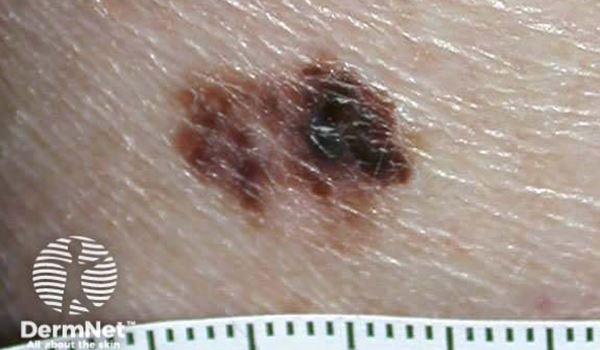Skin Cancer
What is skin cancer?
Skin cancer is a common type of cancer caused by the abnormal growth of skin cells. It often occurs on areas of skin exposed to sunlight; however, it can still develop in other regions not exposed to the sun.
This page contains information and resources on skin cancer, including:
- Symptoms of skin cancer
- How skin cancer is diagnosed
- How skin cancer is treated
- Resources containing useful information and support

Where does skin cancer come from?
- There are two main types: non-melanoma and melanoma
- Non-melanoma cancer can be divided into basal cell carcinomas (BCC) and squamous cell carcinomas (SCC).
- BCCs (75% of skin cancers) come from basal cells, where new skin cells are produced as old ones die and slough off. They are also called rodent ulcers.
- SCCs (20%) come from squamous cells which make up the middle and outer layers of the skin. At early stages, SCCs are also called Bowen’s disease.
- Melanoma is a different type of skin cancer that is less common and comes from melanocytes, which are cells responsible for the pigmentation of skin. This is more serious and more likely to spread to the rest of the body.
What to look out for?
Non-melanoma cancers can appear in several forms, but usually grow slowly and are painless. On the right is an example of a BCC (image taken from DermNet NZ):
Common symptoms include:
- Skin patch that appears unusual compared to the surrounding areas
- Skin patch that is itchy, bleeds, crusts or scabs for more than 4 weeks
- A sore or ulcer that does not heal within 4 weeks
- A growth that is raised and smooth with clear edges
- A firm lump that is slow-growing, shiny, pink or red coloured
Some of these symptoms can also be present in other conditions.
If you have any of these symptoms or are worried about any unusual patches of skin, please check with your GP.

Melanoma
Melanoma can appear as a new mole, a change to a pre-existing freckle or mole, or simply a change in a previously normal patch of skin. It can appear as a mole that is bleeding, crusting, unusually itchy or painful. On the right is an example of melanoma (image taken from Dermnet NZ)
The ABCDE checklist can be used to distinguish between a normal mole and melanoma:
- Asymmetry: does the mole have an irregular shape?
- Border: does the mole have jagged or blurry, undefined borders?
- Colour: does the mole have multiple different colours within it?
- Diameter: is the mole larger than 6 mm in diameter?
- Evolution: is the mole changing in size, shape or colour?
If the answer to any of these questions is yes, please contact your GP.

What risk factors are there?
The biggest risk factors for all types of skin cancer are exposure to ultraviolet (UV) light – from the sun or sunbeds – and sunburn.
Other factors that increase your chances of developing skin cancer include:
- Older age
- Pale skin that burns easily under the sun
- Large number of moles and freckles
- Past history of skin cancer
- Past family history of skin cancer
You can lower your risk of skin cancer by protecting your skin and being careful under the sun. Be sure to apply sunscreen regularly or wear long-sleeved clothes to reduce UV exposure.

What if I find something unusual?
If you find any abnormal moles, growths or sores, see your GP. The earlier skin cancer is discovered, the easier it is to treat.
Let your GP know about:
- Your health and any symptoms
- Amount of sun exposure
- Any recent changes to the affected area of skin
- Any past instances of skin cancer in your family
Your GP will examine the affected area and may also take photographs to send to a dermatologist - a skin specialist - to review.
If the GP suspects you could have skin cancer, you will request an urgent referral for further investigations and see a dermatologist in the hospital. A small area of skin may be removed for biopsy and examined to check for cancer.
However, this does not necessarily mean you definitely have cancer. There are other possible skin conditions which could cause similar symptoms, and it is important to rule those out before moving forward.

What if it really is cancer?
If it is confirmed that you have skin cancer, further tests may be required to determine how advanced it is and how far it has spread. These include blood tests, CT or MRI scans, or tests to see if the cancer has spread to your lymph nodes.
You will be managed in the hospital by a multidisciplinary team (MDT) made of medical professionals from different specialties who cover various aspects of your treatment.
Members of this team include:
- Clinical nurse specialist - your main point of contact during the treatment process
- Oncologist - doctor who specialises in cancer and decides on the type of treatment needed
- Plastic surgeon - surgeon who is responsible for removing the cancer and lymph nodes (if required)
- Pathologist - specialist in examining the biopsy sample under the microscope

What treatments are there?
- The main treatment for skin cancer is surgical removal of the growth. However, this depends on various factors, including the type of cancer, location, extent of spread and your general health.
- Chemotherapy or radiotherapy may also be required if the cancer has progressed to a more advanced stage.
- The MDT will explain the full process to you, including the procedures involved, risks, benefits and side effects. You will also have regular checkups during and after the treatment process.
Community Resources
The Clinical Nurse Specialist will be able to provide you with help regarding support services in your local area. This page also includes several online resources containing further information that may be useful.

Page created: 04 September 2020




